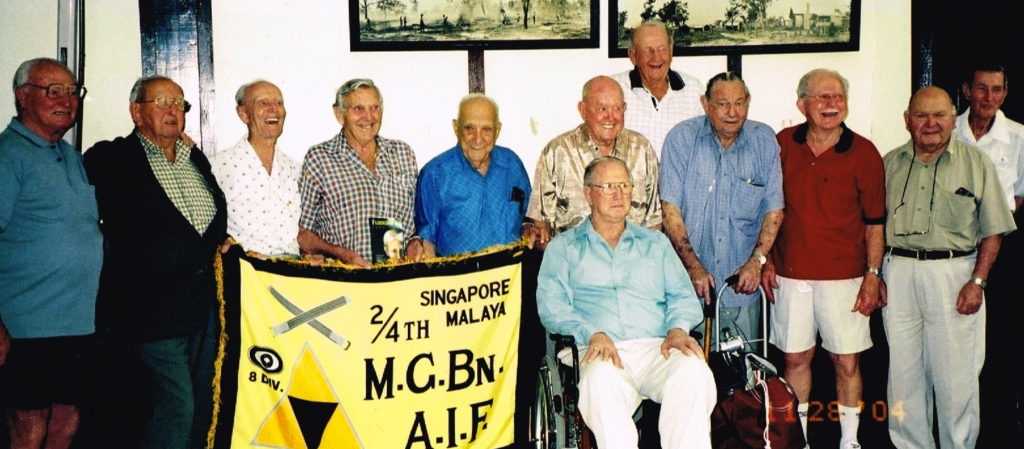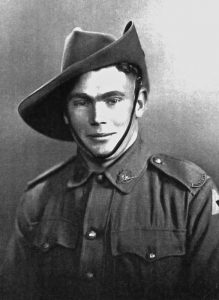The Soldier's Details

- Surname:
- Badock
- First Name:
- Ronald Collett
- Nick Name:
- Ron
- Rank:
- Private
- Regimental #:
- WX8729
- Company:
- 'B' Company
- Enlisted:
- 23.10.1940
- Discharged:
- 25.02.1946
- DOB:
- 31.01.1919
- Place of Birth:
- Kalgoorlie, Western Australia
- Father's Name:
- Charles Frederick Badock
- Mothers's Name:
- Ivy Euphemia Badock
- Religion:
- Church of England
- Pre-war Occupation:
- Miner
- Singapore:
- Selarang Camp Changi, Johore Bahru, Adam Park, Sime Road Camp, Selarang Barracks Changi.
- Force:
- 'D' Force Thailand, Captain Harris Party
- Camps Thailand:
- Kanchanaburi, Tarsau, Kinsaiyok, Chungkai (evacuated sick by barge) Non Pladuk
- POW#:
- 4/5886
- Return Details 1945:
- Saigon-Bangkok-Singapore by aircraft, Singapore-Sydney, HMT Highland Chieftan, Sydney-Adelaide troop train, Adelaide-Perth by aircraft.
General Description
Ron enlisted AIF 23 Oct 1940 and later joined 2/4th MGB’s ‘B’ Coy 8 Platoon under Commanding Officer Lt MacKinnon.
As a POW in Singapore he joined work parties going to Jahore Bahru, Adam Park and Sime Road. Ron was sent to work on the Burma-Thai Railway with ‘D’ Force S Battalion.
Please read further.
We believe Ron was separated from this main party sent to work at Hellfire Pass – he ended up spending time with Captain. Harris Party. During this time he was evacuated sick from Kinsayok to Chungkai. When sufficiently recovered he was sent to Non Pladuk Camp.
Capt. Fred Harris from his War Affidavit:
‘I was in captivity at Kanchanaburi camp, Thailand from 1st April 1943 until May 1943. I was in charge of a working party of approximately 200 men, half English and half Australian. We were working on a night shift, loading ballast trains on the Kanburi River.’
It is thought that 19 or more men from 2/4th were connected with Capt. Harris. This party is recorded being at Non Pladuk on 4 March 1944.
Read further about Capt Harris Party
From here Ron was selected with ‘Both’ Party to go to Japan – only they didn’t get to Japan, and they remained in Saigon, French-Indo China.
Ron was recovered from French Indo-China at the end of war.
Also read about the boys from Norseman.

Ronald Collett BADOCK was born 1919 to Charles Frederick and Ivy Euphemia ‘Effie’ Baker in Kalgoorlie.
Below: is family photograph soon after Charles Frederick known as ‘Fred’ Badock died in 1927 of a brain tumuor. He was a railway employee and pianist in a Goldfields dance band. Ivy had already buried two infant sons: Charles Badock [1912] and Leslie Badock [1921-1922]. At the time of this photograph Ivy was forced to send her two eldest sons to a Perth Orphanage for two year, sister Effie went to Tarcoola siding to live in a tent with her aunt. A terrible time for Ivy to be separated from her and not knowing when she would be with them again.
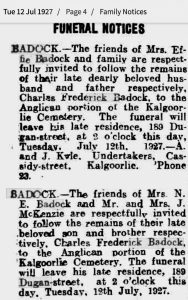
It was not until 1930 when Ivy remarried that she was able to bring all her children together as one family.
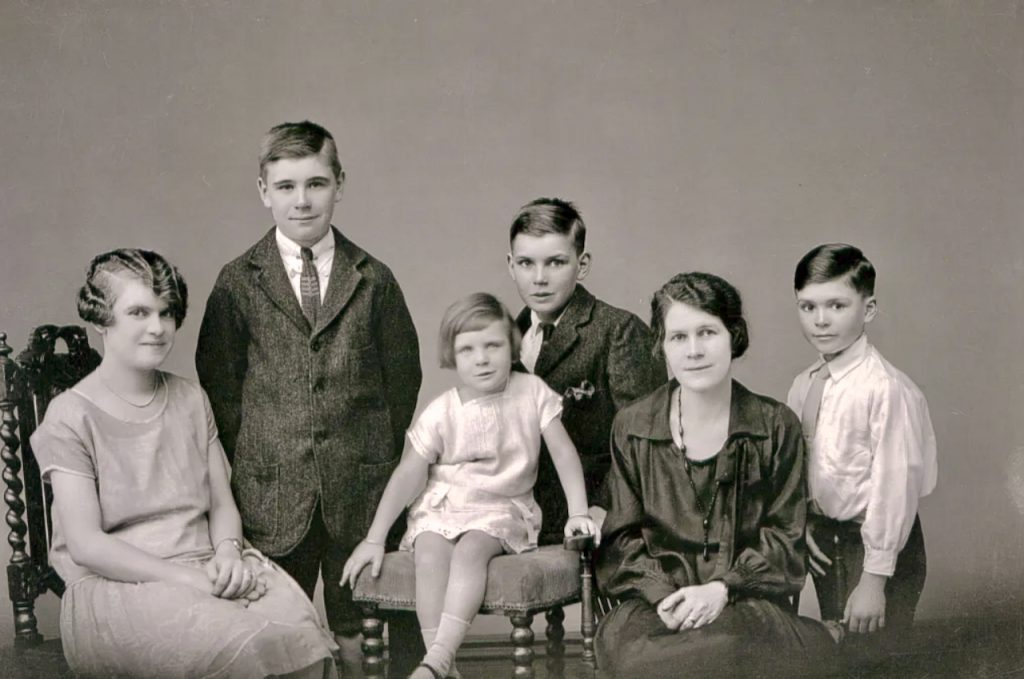

Nellie Clayton (nee Badock) 1910-1940 died 13 years later having her 6th child in 10 years she is buried in the Kalgoorlie Cemetery near her infant brothers and father.
Reginald Badock 1914-1966 saw war service, was a chef on the WA Government Railways and was hit and killed at Perth Railway Station reporting for a late work shift. He left 6 young daughters.
Effie James (nee Badock) 1923-2017 was a telephonist at Norseman, Kalgoorlie, Boulder, Merredin, Guildford and Perth GPO from 1937-1946. She married and moved to Whyalla in 1946 but always called WA home. Over the years Ron would visit his sister Effie in South Australia.
Below: Ron’s father Fred had one brother and one sister. His brother Alfrerd ‘Reg’ Badock died aged 27 years at Broken Hill in 1912.
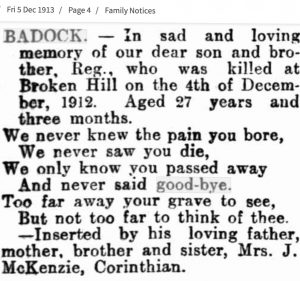
Above: Just six months prior to his father’s death, Ron’s Grandfather Alfred Kyle Badock died in Kalgoorlie.
Below: Funeral notice for Ron’s father Charles ‘Fred’ Badock.
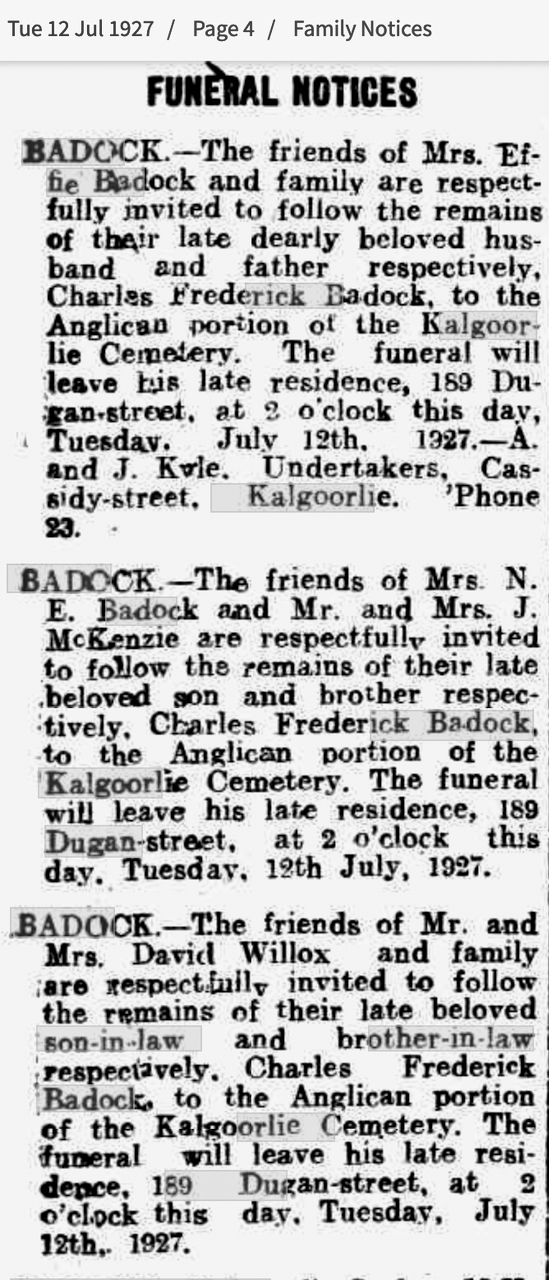
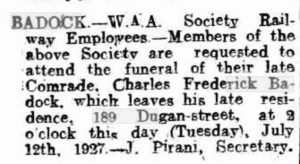
Below: Ron’s Grandmother Ellen Elizabeth Badock, his father’s mother died in Kalgoorlie 1932.
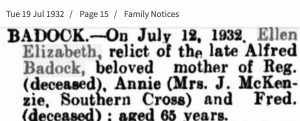
Ron loved his Aussie Rules Footy and played in Kalgoorlie, Norseman and 2/4th at Northam. Please read further
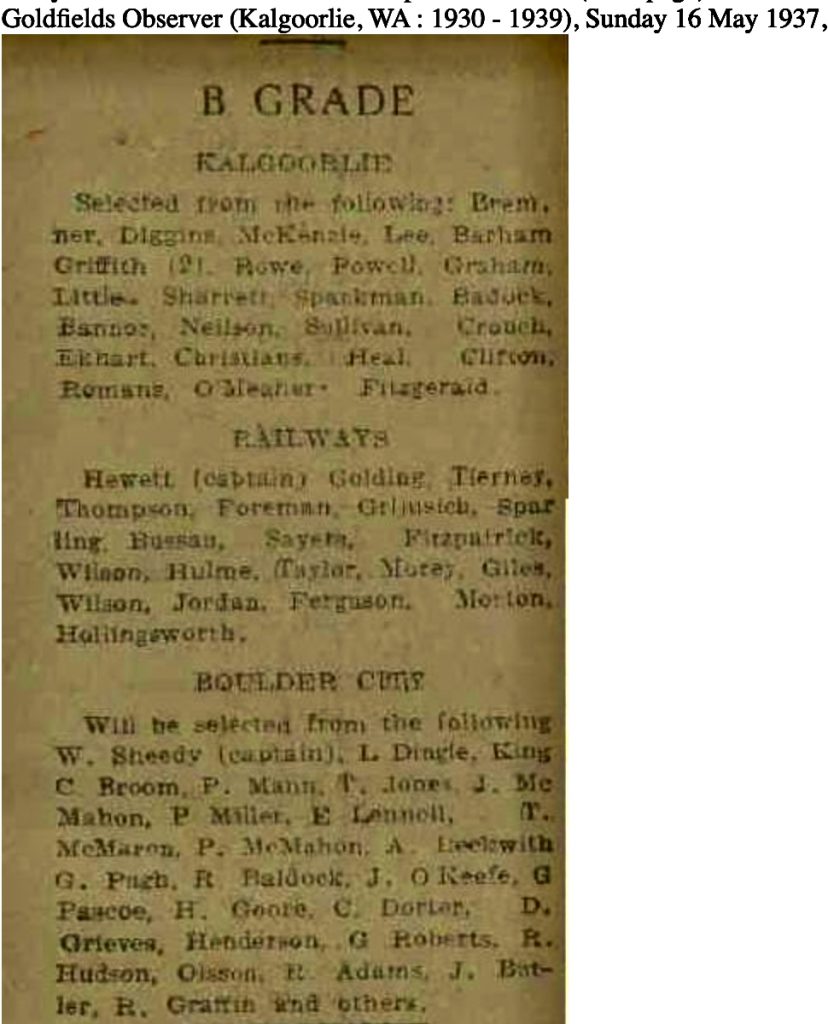
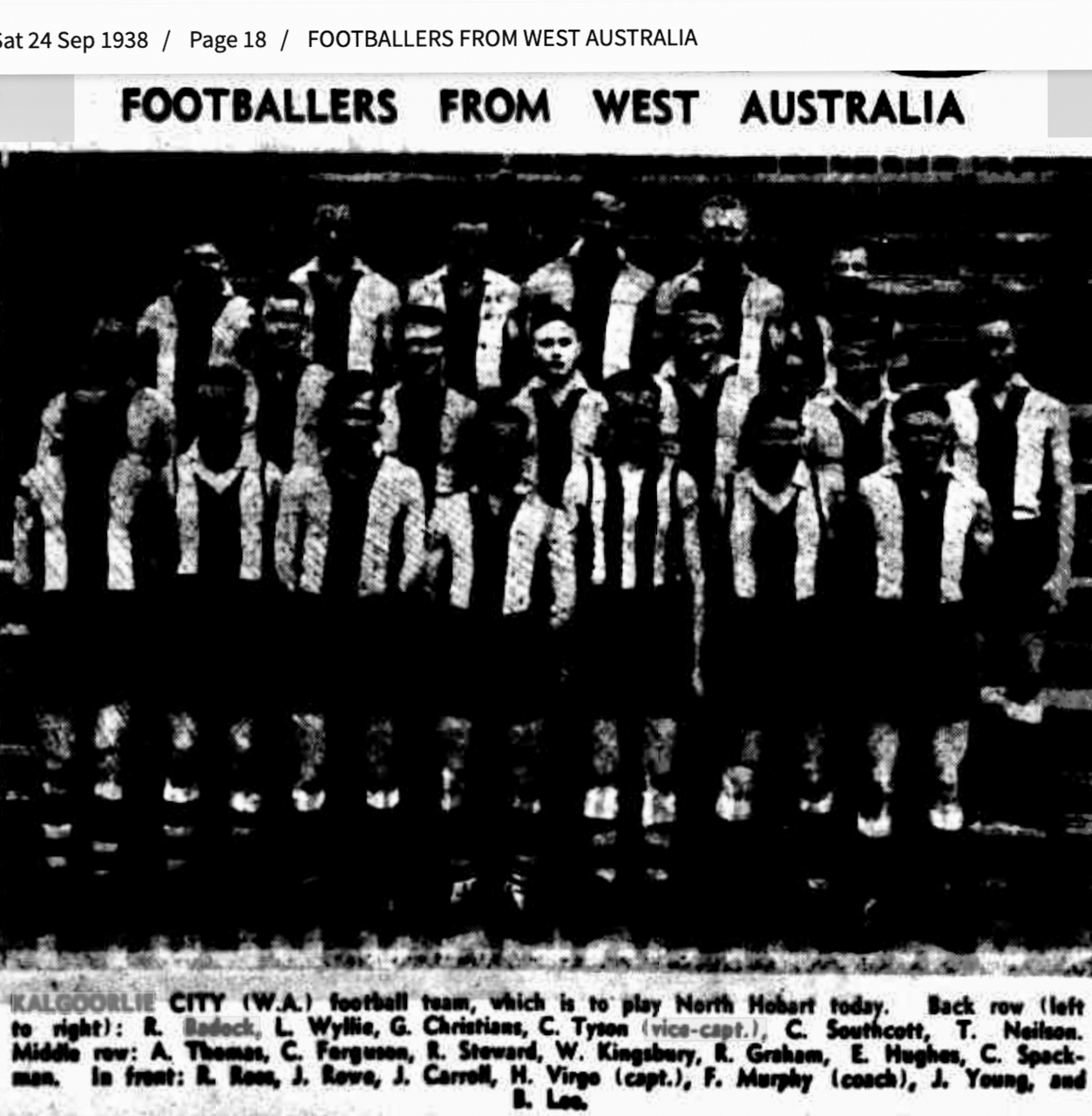

Below: Buffalo Cricket Club

Below: just another sporting interest for Ron – Rifle Club
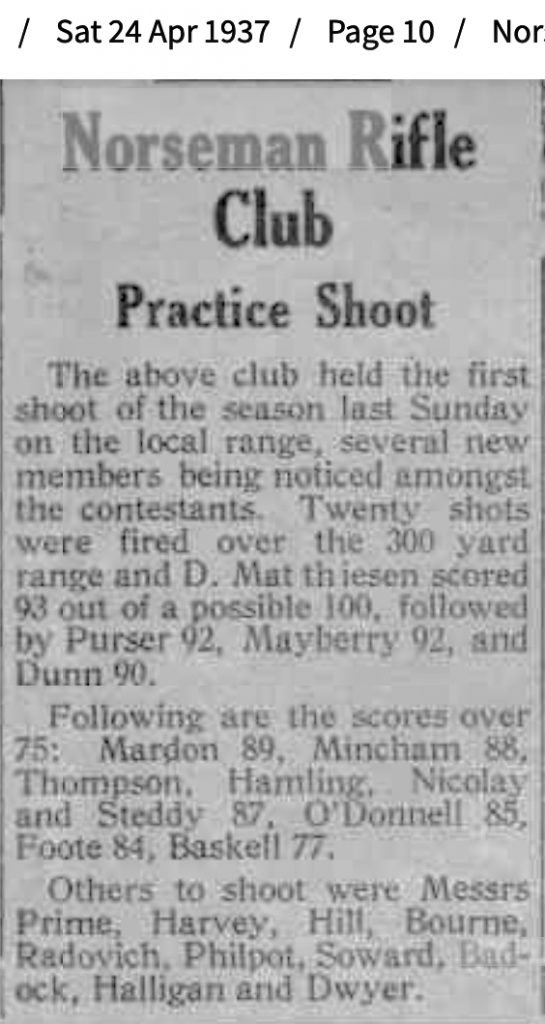
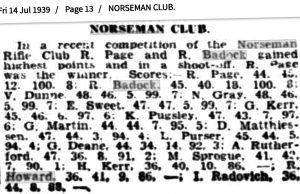
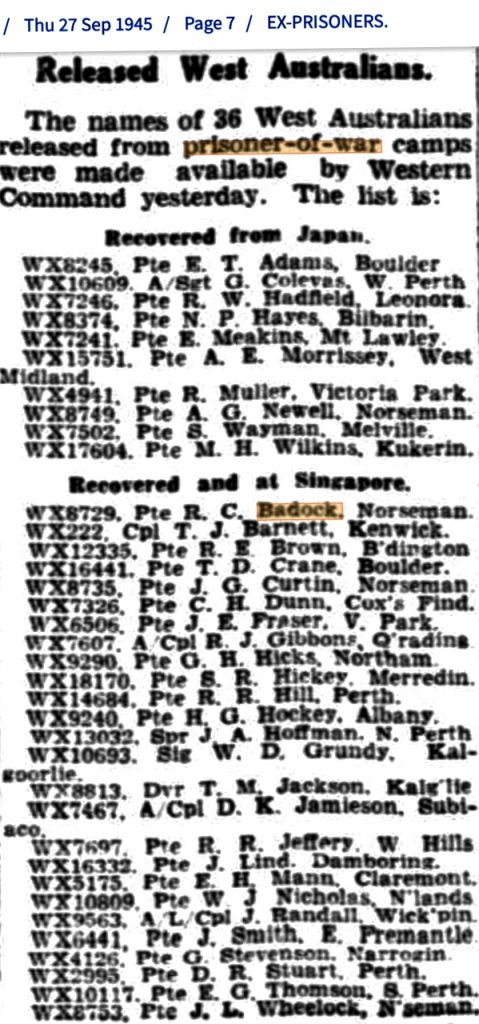
Below: Ron marries Vera in 1950.
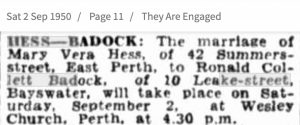
Ron celebrated his 97th birthday this year, 2016. Ron meets with the 2/4th Committee on a monthly basis. In the past
he has been an active member holding several positions, the last being Treasurer until about 2010. Ron can only be described as a gentleman whom we all admire and whose company and knowledge we appreciate more than we can say.
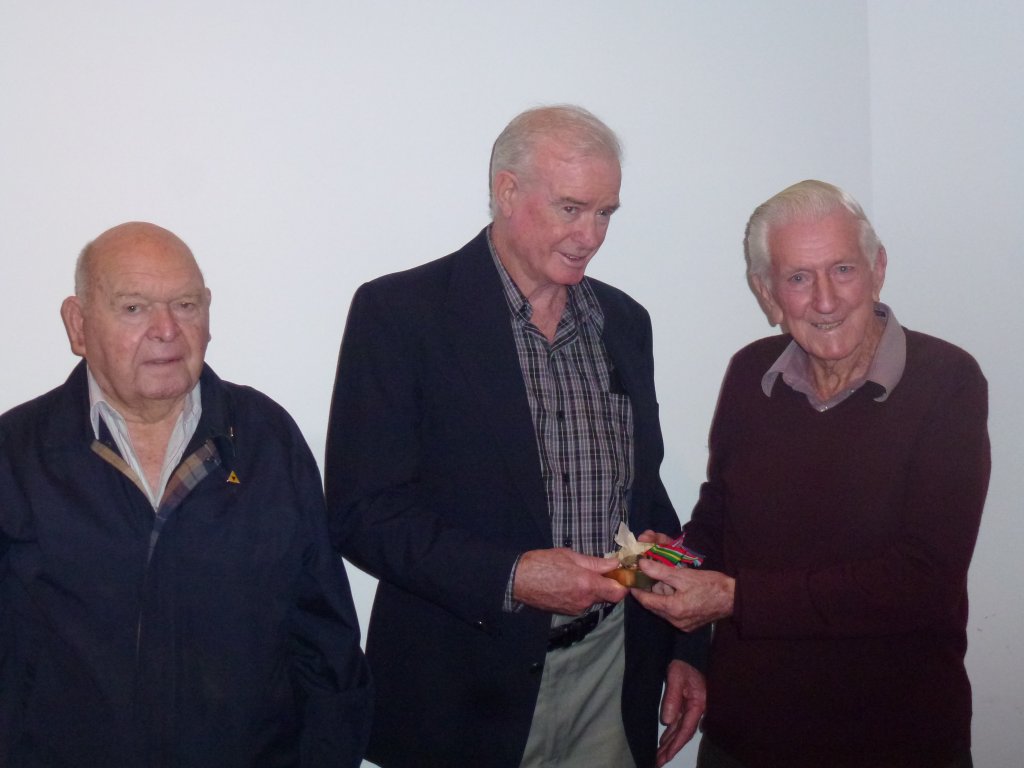
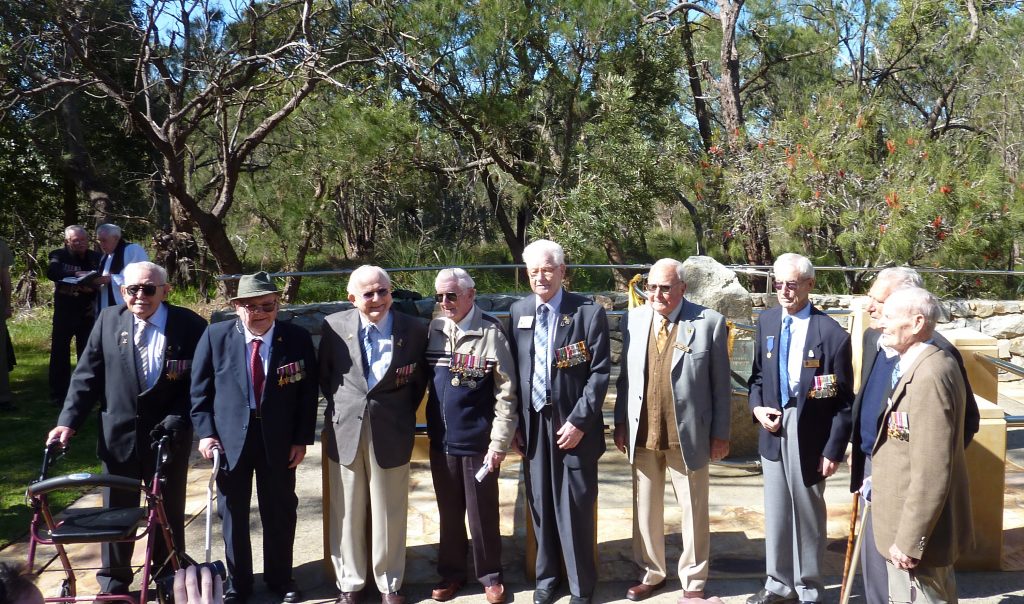
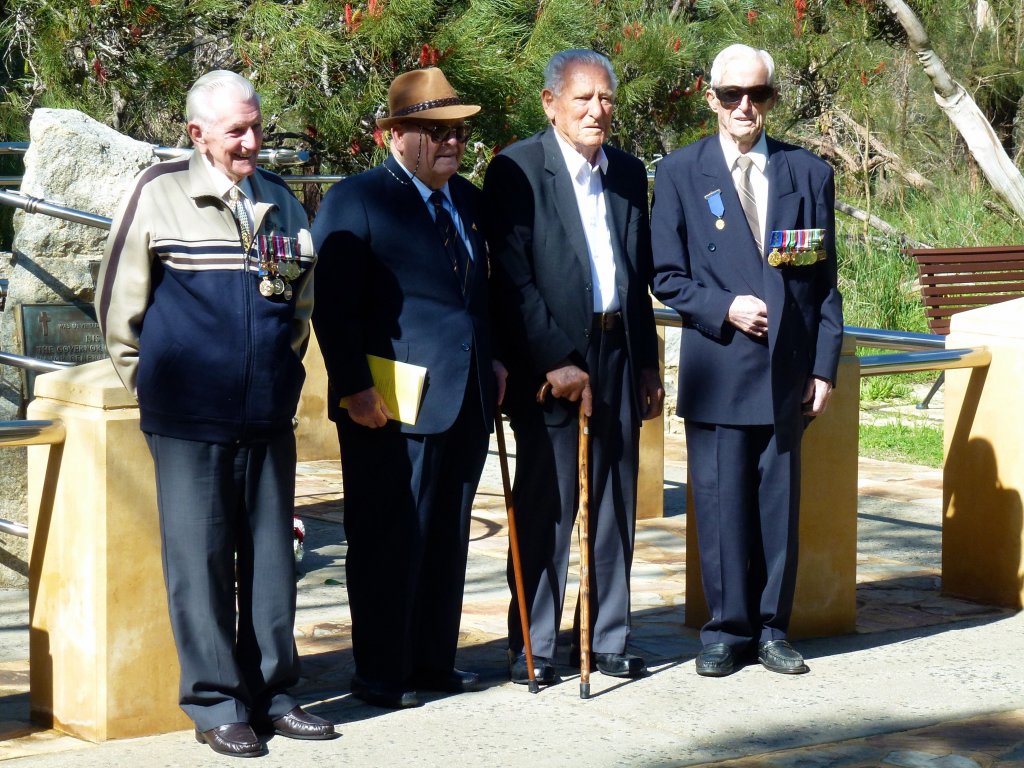
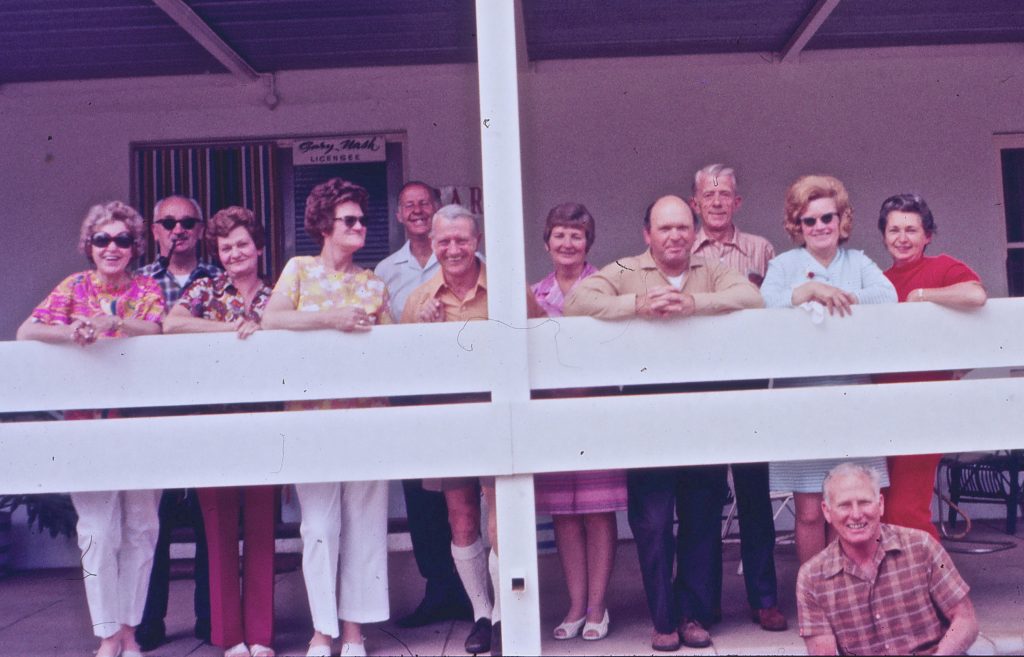


Con Ryan, Wally Limb and Ron Badock

Rear L – R —, Tom Hampton, —, Les Kemp, Norm Ablett, …, Jack Kyrios, Ted Elliot.
Front L – R, Jim Gilmour, John Gilmour, —, Ron Badock, Jim Elliot.
Trevor James, Jim Burns, Alf Worth, John Lane, Des Colevas, Bob Whitield, Joe Pearce (rear), Tom Pilmoor (front), Owen Morris, Jim Elliott, Ron Badock, Gordon Lynam
View Peter Winstanley’s video interview of Ron Badock, WX8729.
Read about Norseman’s Enlistments
Below: Ron with John Gilmour, veterans at 2/4th Service.
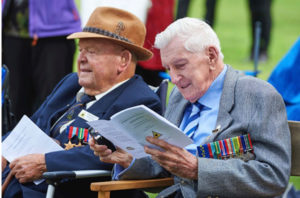

Below: Ron’s mother receives good new in Sep 1943.
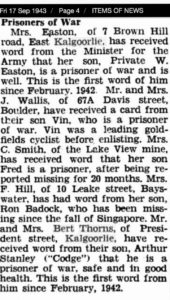
Please read the story of Ted Keating from Kalgoorlie as told to us by Ron
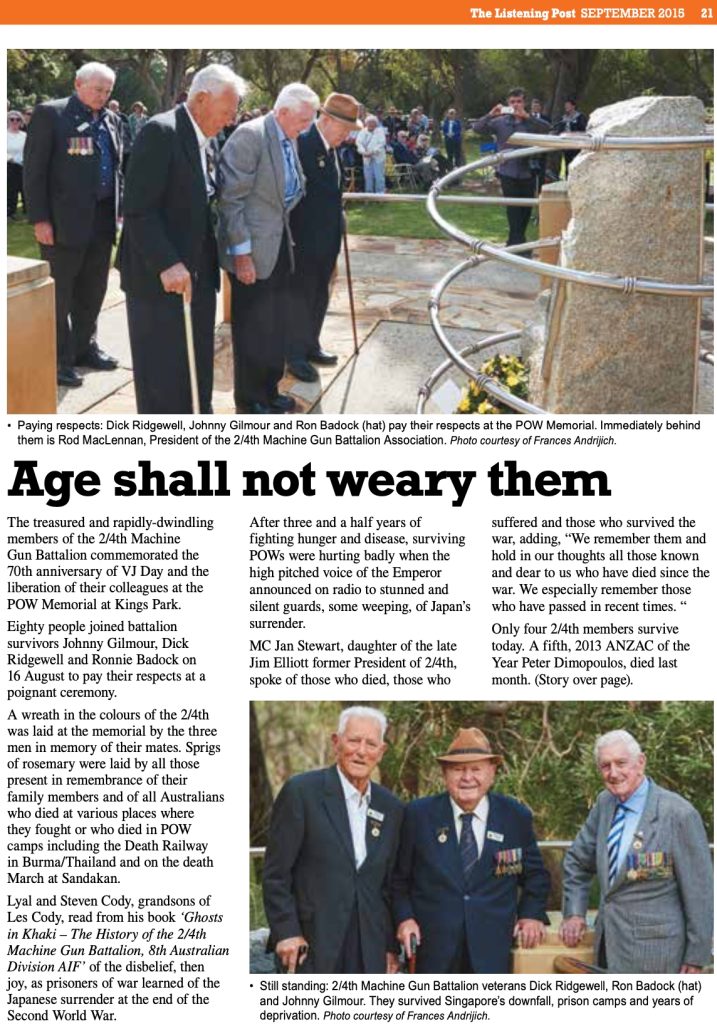
14 December 2016.
It is with great sadness that we announce the death of our Committee Member and veteran Mr. Ron Badock on 1st December 2016. Ron had spent the few months in and out of hospital. As is his nature, he remained chirpy, always interested in others and never complained. Ron would have celebrated his 98th birthday on 31st January 2017.
He will be greatly missed by the 2/4th Committee and we express our deepest sympathy to the Badock family who has always been strongly associated with the Battalion.
We can be assured Ron’s interest and knowledge of the 2/4th, which never waived throughout his life, will continue wherever he travels.
God Speed Ron, may the sun always shine for you.
It was our pleasure to enjoy your friendship.
A Personal 2016 Tribute
By Phil Badock son of Ronald Badock (WX8729)
At our regular Friday afternoon whisky appreciation sessions, conversation would invariably include recollections of my father’s wartime experiences. I was blessed that my father lived well into his 98th year and he was mentally acute to the end. I asked many questions but I now wish I had asked many more. One question I asked was “What did you do when you were a Prisoner of War (POW)? His response, “Anything and everything”.
The following are some of his recollections and it is my honour and privilege to share these before they are gone forever.
Ron Badock, born on 31 January 1919, enlisted in the army from Norseman WA in 1940. He started out on the troop train that commenced its journey from Esperance picking up prospective soldiers along the way at Salmon Gums, Norseman, Widgiemooltha, Coolgardie, Southern Cross and wheatbelt towns along the train line down to Perth.
“Never saw so much beer drunk as on that train” he said, including seeing Ted Keating (WX8818) carrying a 5 gallon keg on his shoulder running to catch up to the train as it slowly departed from Coolgardie station. Ted Keating later was a POW with ‘E’ Force in Borneo and died on 11/2/1944 at Kutching.
Pte Robert Leighton “Bloocher” Smith (WX8736)

Ron was 21 when he enlisted with family friend “Bloocher’ Smith. Ten years older than Ron, Bloocher told Ron’s mother Effie that he would look after young Ronnie and see that he safely returned. Ron and Bloocher were assigned to 8 Platoon B Company of the newly formed wholly Western Australian raised 2/4th Machine Gun Battalion.
Bloocher was killed in action on 11 February 1942 at Mandai in the eight day Battle for Singapore. According to Ron, Bloocher was taking cover and poked his head around the corner of a village hut and was shot between the eyes by a sniper. Death was instant. While obviously tragic for Bloocher, Ron said that he would never have survived being a POW as befell the 2/4th and the thousands of other Allied personnel from February 1942 to August 1945. Bloocher was a big man and was not one to easily take orders.
Bloocher Smith was one of three brothers who did not return after the war. The 2/4th also had the three Dorrizzi brothers and the three Newling brothers who did not survive. What a terrible sacrifice these families endured.
Sgt Richard Henry “Dick” Sandilands (WX8809) and Pte Raymond Francis “Bones” Carruthers (WX7325)

Dick Sandilands was the 8 Platoon Sergeant and was highly regarded by all the men. At Mandai on 11/2/1942 he was shot in the back and paralysed from the waist down. Without any chance of survival or retreat he faced the enemy with his revolver to a certain death.

“Bones” Carruthers, he of slight build, was one of the younger members of 8 Platoon and the 2/4th. Aged just 22 he met his end also at Mandai on 11/2/1942. Shellshocked and disoriented, Bones was last seen standing frozen on a rocky outcrop.
Pte Leo Patrick “Squasher” Walsh (WX8776)

Ron was selected as a No. 1 gunner in 8 Platoon and Leo “Squasher” Walsh was his No. 2. The No.1 gunner was the one who fired the Vickers Machine Gun and the No.2 fed the ammunition into the gun. During their training, on the signal the No.1 gunner would roll aside and the No. 2 would take the place of the No. 1. Thinking this was just an exercise drill it was sometime later in their training that they realised why the No.1 had to roll aside and the No. 2 had to take over. This was because in the course of a battle if the No.1 was killed the No. 2 would replace him and the No. 3 would become the new No.2. No.1 gunner’s role was to carry the 42lb (20 kg) tripod on which the gun sat. No. 2’s job was to carry the gun and mount it to the tripod.
The Vickers Machine Gun was used in World War 1 and it was said that the gun could fire continuously for a period of 24 hours if the ammunition was kept being fed and the water cooling condenser system remained efficient as it did on occasions on the Western Front.
Prior to the war Leo was a locksmith for the Chubb Safe Company and his locksmith skills would become important in the heat of battle.
On one occasion during action Ron, carrying the tripod and Leo the gun, were running across a field and encountered a wide ditch. With fear and adrenalin pulsing they both leapt across the ditch with their equipment. “Amazing what adrenalin does to your body when you have to”, explained Ron.
8 Platoon was attached to 2/30 Battalion and they were involved in a number of actions. With the Japanese being able to cross the Strait of Jahore the Platoon fell back from their original position just west of the Causeway linking Singapore with mainland Malaya. They then established position around Mandai Rd, were again forced to fall back but were ordered to move forward again to provide covering fire for the retreating troops of D Coy 2/30 Btn.
In one of these actions the Vickers became a ‘runaway swinging traverse’ meaning that Ron had no control over the weapon. While under the pressure of being fired upon, Leo Walsh was able to disengage, repair the mechanism and re-engage the gun so it could once again be controlled.
Almost encircled, the Platoon finally retreated to their truck where they all had their belongings in their army kitbags. Lt Graham ‘Speed’ MacKinnon (WX3707) the Officer Commanding 8 Platoon attempted to destroy the truck and its contents by firing a bullet from his revolver into the petrol tank The bullet merely bounced off the heavy metal and plopped to the ground.
With time of the essence, the truck, the Vickers machine guns, remaining ammo, provisions and soldier’s belongings were abandoned and the men hastily made their exit across country to safety. Thus, the men had nothing but the clothes on their back and a rifle for some. They then made their way on foot and in small groups following the water pipeline back to the Singapore Golf Course where they reformed.
‘Speed’ MacKinnon was later recommended for the Military Cross for his outstanding leadership under extreme conditions which successfully held the enemy for two hours while all the men of D Coy 2/30 Btn could successfully withdraw without any casualties. Unfortunately the medal was never awarded.
‘Speed’ MacKinnon earned his nickname when on his return from Officer Training School he strode to his men with all the pomp and official paraphernalia worn by an officer. One wag said he looked like Speed Gordon, a popular cartoon character of the day, and the name stuck. But in the heat of battle the men of 8 Platoon were grateful for the leadership displayed by ‘Speed’ MacKinnon.
In later years Graham Mackinnon became a Member of Parliament and Minister in the WA Government. He was also a former president of the 2/4th Machine Gun Battalion Ex Members Association.
Leo and all Allied personnel became Prisoners of War upon the surrender on 15 February 1942. He was part of ‘A’ Force that went to Burma in 1943 to help build the Burma Thailand Railway. Ron was part of ‘D’ Force which was sent to Thailand for the same purpose. On the railway’s completion Leo was returned to Singapore and was one of the contingent of 718 Australian POWs including 52 men from the 2/4th who boarded the cargo ship Rakuro Maru bound for Japan.
In the early hours of 12 September 1944 the Rakuro Maru, and other ships in its convoy, were attacked by American submarines in the South China Sea. Not knowing the Rakuro Maru was transporting Allied POWs the USS Sealion fired the torpedoes which hit the Japanese ship. Leo abandoned ship like all the POWs and made his way to a makeshift raft where a number of other men were clinging. At some point it was decided there were too many men attached to this and Leo volunteered to swim to another raft which had less men holding onto it. Leo had been a strong swimmer who in his early adulthood swam in the annual Swim Through Perth a three mile event on the Swan River. Leo was now a 36 year old and had been a POW for two and a half years. Leo set off but was never seen again.
He was one of 38 men from the 2/4th to perish in the open ocean over the days and nights of 12 – 16 September, and possibly later. No food, no water and no hope, each man quietly coming to terms with his own impending demise. Having all lived through the Great Depression of the 1930s, surviving the Battle for Singapore and persevering through the trauma of the Burma Thailand Railway there was no shortage of will to live on their part. Their names are remembered overleaf on the coming 80th Anniversary of this wartime event and of their supreme sacrifice.
Miraculously 14 men from the 2/4th did survive the sinking of the Rakuro Maru. Eleven were picked up by the US submarines Pampanito, Sealion, Queenfish and Barb from the afternoon of 15 September to the evening of 17 September Their war and POW days were now over! Altogether 155 Allied POWS were saved by the crews of the 4 US submarines.
And three 2/4th were picked up by a Japanese vessel. These men eventually landed in Japan and continued life as POWs but one was later killed in a US bombing raid.
Sgt John William ‘Jack” Sanderson (WX8777)

Jack Sanderson was a family friend from Kalgoorlie. He was a commercial traveller for Sandovers and his patch ran from Wiluna in the north to Esperance in the south and all points in between. On fit-out for his army uniform there was not one big enough as Jack was a large tall man and his uniform had to be specially made.
Jack was originally in 7 Platoon B Company but was promoted to Sergeant and assigned to 9 Platoon. He lost his life at Tarsau, a POW camp situated along the River Kwai in Thailand, and was skeletal at time of death. Ron was present with Jack when he died on 18/7/1943. Ron had a theory formulated through bitter observation, that small to medium sized men could just survive on the meagre 500 calories per day but large sized men like Jack Sanderson could not sustain life on that ration. Thus, the ultimate example of natural selection.
Pte Arthur Stanley “Codgee” Thorns (WX10289)
Codgee as he was known from childhood was a schoolmate of Ron Badock at Kalgoorlie Central. He was in 7 Platoon B Company and as a POW was in ‘E’ Force which was sent to Borneo. He was in the second or last infamous death march from Sandakan to Ranau in May/June 1945. He was one of the few who survived that ordeal but at Ranau on 8th August 1945 he was beaten to death by the Japanese in the hope they would erase all evidence of atrocities committed by them. Note the date of death, just one week before the Japanese Government surrendered.
John Philip “Jack” De Gracie
Jack De Gracie was an Able Seaman aboard HMAS Sydney when it was sunk with all 645 personnel lost on 19 November 1941. Because of his tall and imposing frame
Captain Collins personally selected Jack to join the crew of the light cruiser. Jack joined the Sydney and on his maiden voyage lost his life in the battle with German raider MV Kormoran. As an aside, in the meantime Collins had been replaced by Captain Burnett. Such are the vagaries and fates of war. Collins was not on board at the sinking but Burnett was.
Jack De Gracie played football with and against Ron Badock in Norseman. He was a ruckman and Ron a rover. Ron won the Association Best and Fairest Player Award in 1939 and Jack was the runner-up. As Ron would say, “a win for the short arse over the big bloke”.
Ronald Collett Badock died on 1 December 2016 two months before his 98th birthday. Another win he would probably say, given he and his returning mates of the 2/4th were told by Army Medical Officers they would not live to see the age of 60 given their privations as Prisoners of War.
Ron Badock, just one of approx 1000 men in the 2/4th, was an ordinary soldier who survived extraordinary times. Through fortitude and luck he was able to return to tell his story and lead a long and fruitful life. All other members of the 2/4th had their own story, for some, however brief. Through mateship and adversity their bond was unbreakable until the last.
To the men of the 2/4th, and others, your names liveth on.
At the going down of the sun,
and in the morning,
We will remember them.
Lest we forget.
Camp Locations:
- Johore Bahru, - Malaysia
- Selarang Barracks Changi - Singapore
- Selarang Camp Changi - Singapore
- Sime Road Camp - Singapore
- Chungkai, 60k - Thailand
- Kanchanaburi, 50k - Thailand
- Kinsaiyok Main, 170.2k - Thailand
- Non Pladuk, 0k - Thailand
- Tarsau, Tha Sao 125k - Thailand
- Saigon - French Indo China

